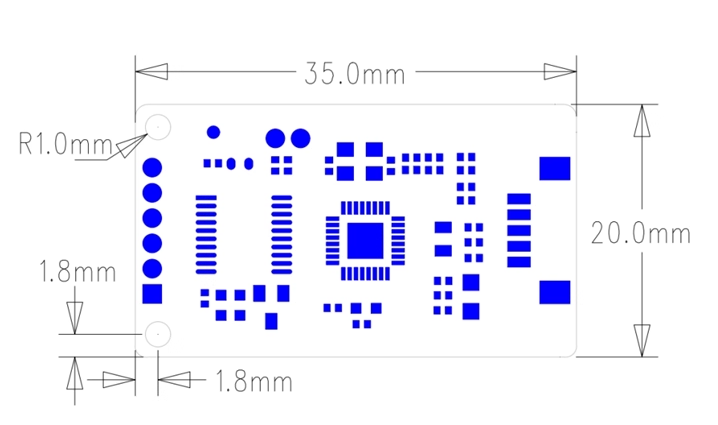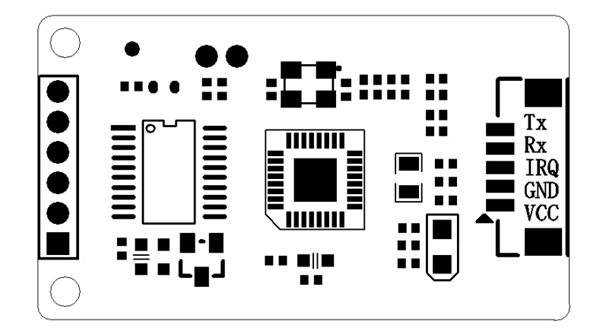Support ISO14443-A and IS014443-B protocols;
Support Mifare Card operation;
Integrated onboard antenna;
Built-in card polling function;
Supports up to 2 physical serial ports;
Wiegand protocol (WG26, WG34);
Small size: 20mm*35mm;
1 Product Introduction
This series of card readers is an NFC reader/writer module launched by our company. This module integrates an antenna, has the characteristics of small size, long card reading distance, and supports multiple protocols. It is a NFC product with strong versatility and stability. The module can perform excellent card swiping performance in application scenarios such as smart locks, Access Control, charging piles, cabinet locks, etc., greatly shortening the product development cycle for customers and providing a good user experience for the product.
1.1 Functional characteristics
Support ISO14443-A and IS014443-B protocols;
Support Mifare Card operation;
Integrated onboard antenna;
Built-in card polling function;
Supports up to 2 physical serial ports;
Wiegand protocol (WG26, WG34);
Small size: 20mm*35mm;
1.2 Application areas
[1] Lock applications: smart locks, locker locks, luggage locks, car locks;
[2] Hotel applications: room card readers, hotel locks;
[3] Attendance applications: attendance machines, patrol machines;
[4] Small consumption: charging piles, canteen meal card terminals Equipment
[5] Regional card: campus card system, city card, bank card system and other terminal equipment;
[6] Intelligent water, electricity and gas meters;
1.3 Technical parameters
Working power consumption: 40mA-100mA, depending on the card type and distance
Working frequency: 13.56MHz
Card reading distance: M1 can reach 5cm, CPU card is about 1cm
External interface: Uart interface, (Weigand, l2C optional)

2 Working mode
2.1 Mode introduction
The module has built-in embedded software and supports the following two working modes:
1. Automatic card search mode: It is the default mode after the system starts. In this mode, the system searches for cards at a periodic interval of 300ms. If the card search is successful, a report will be sent to the host through the serial port (refer to 2.3 for the specific data format);
2. Command processing mode: It is a high priority mode. If the system receives a command from the host, it will immediately switch the mode to the command processing mode and execute the relevant command tasks. For the specific command interface protocol, please refer to Chapter 3 for the description.
2.2 Mode switching mechanism
1. After the system is powered on, it works in the automatic card search mode by default;
2. Automatic card search frequency: 3Hz;
3. When receiving a host command, it will switch to the command processing mode immediately;
4. If no new host command is received within 5 seconds, exit the command processing mode and return to the automatic card search mode;
2.3 Automatic card search report frame format
Name Frame Header Uid Length UID Check Code
Length/Byte 4 1 4-8 1
Content 00FF00FF4-8 Card ID0xxx
1. If the same card is read every time for a long time, the card ID is reported every 3 seconds;
2. Check Code is the byte XOR operation result of the two data segments Uid Length + UID.
3 Interface Protocol
3.1 Physical Interface
1. The module is equipped with serial communication as standard, and the interface parameters are as follows:
115200bps, 8bit data bit, 1bit stop bit, no check bit, no flow control bit;
2. The interface diagram is as follows
3 Interface protocol
3.1 Physical interface
1. The module is equipped with serial communication as standard, and the interface parameters are as follows:
115200bps, 8bit data bit, 1bit stop bit, no parity bit, no flow control bit;
2. The interface diagram is as follows


Contact: Adam
Phone: +86 18205991243
E-mail: sale1@rfid-life.com
Add: No.987,Innovation Park,Huli District,Xiamen,China